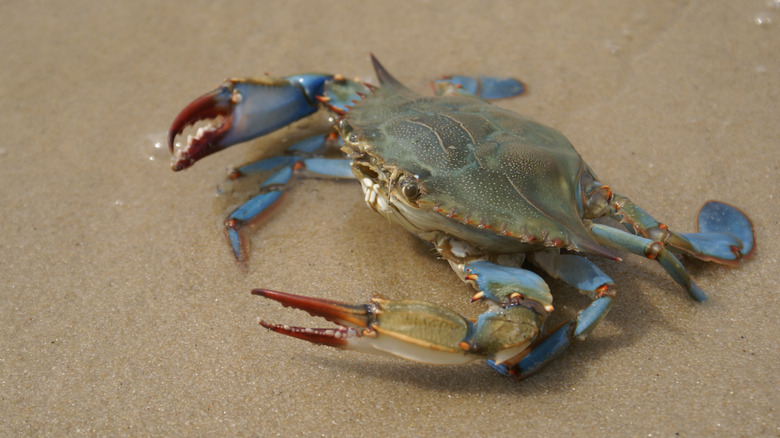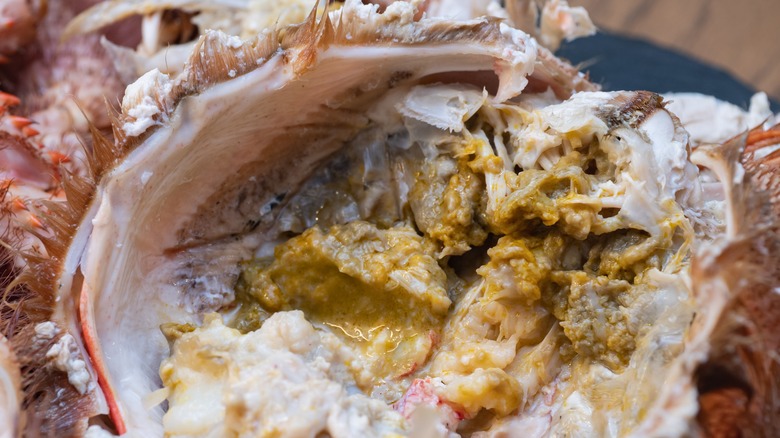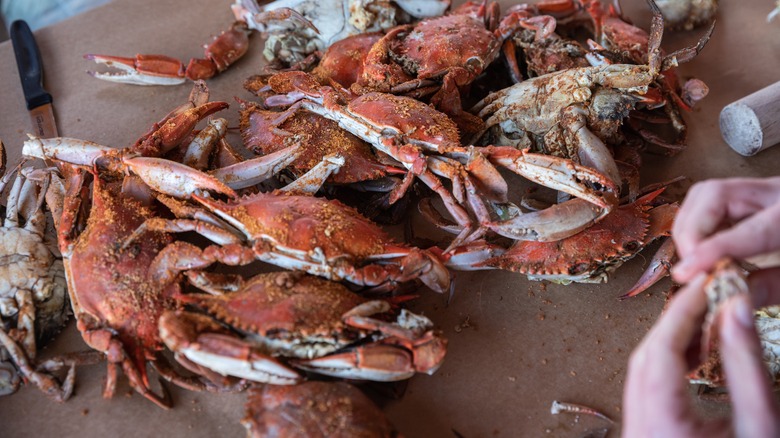The Forbidden Flavor That Makes Maryland's Blue Crabs So Coveted
Blue crab is widely considered to be the official food of Maryland, at least by the scores of people who flock to crab feasts all over the state. They have their own unique style there, steaming crabs in a mixture of beer and vinegar, coating them with ungodly amounts of seasoning (whether it's Old Bay or J.O. No. 2), and most importantly, using only the freshest blue crabs straight from the Chesapeake Bay.
Blue crabs aren't exclusive to Maryland by any means. They can be found all along the Atlantic coast from Argentina up to Canada. However, there's something special about the cold, brackish waters of the Chesapeake Bay that makes the Old Line State's crab hauls one-of-a-kind. Blue crabs hibernate in the winter, and in order to survive the frigid Chesapeake temperatures, they store up large amounts of fat throughout the year. The extra fat gives Maryland blue crabs a uniquely buttery flavor, but that's only part of the appeal.
When you crack open a Maryland blue crab, you will, of course, see the typical white and dark crab meat, but you'll also see a creamy, yellowish goo. The locals call it "mustard," and it is considered one of the most desirable features of the whole crab, beloved for its sweet flavor. Many are under the impression that mustard is just crab fat, but it's actually a certain organ with a very unpleasant job.
People are confused about what blue crab mustard really is
What folks in the mid-Atlantic call "mustard" is also known as tomalley, and it is found in all kinds of crabs, as well as lobsters (in which it takes on a more greenish hue). Many sources have claimed that the mustard is simply the crab's fat, but this isn't the case. It's actually an internal organ called the hepatopancreas. It serves a similar role for crustaceans to what the liver and pancreas do for human beings.
The reason so many people confuse crab mustard for fat is that the hepatopancreas is a fatty organ, and this is especially true in Chesapeake Bay blue crabs because of the extra fat they build up for hibernation. It factors into the butteriness that makes Maryland's crabs so tender and tasty. The way the crabs are cooked also makes a difference. Marylanders steam their crabs rather than boiling them, which helps them retain more of the creamy goo. Many people consider the mustard to be the most flavorful part of the crab, which is why it, and Maryland blue crabs as a whole, have such a passionate fanbase. However, the role of the hepatopancreas in the crab's body brings up some serious concerns about eating it.
The risks of eating tomalley
As previously mentioned, a crustacean's hepatopancreas is roughly equivalent to the human liver and pancreas. That is to say, the hepatopancreas is an organ used for filtering toxins from the body. Marine animals can absorb dangerous toxins from the algae they eat, some of which are naturally occurring and others of which result from human pollution. Heavy metals are a particularly high concern here. Just as you can get mercury poisoning from tuna, crabs pose a similar risk. Blue crab mustard has been found to contain high amounts of cadmium, excess levels of which can cause kidney issues and raise your blood pressure.
Many health officials warn against eating tomalley from any crab or lobster because of the contaminants it might contain. In addition to heavy metals like cadmium, the hepatopancreas can absorb PCBs, industrial chemicals that have been banned for their carcinogenic properties, but still leach into the environment from landfills and hazardous waste sites. There has been a lot of debate over how much of a risk crab mustard really poses, but at the very least, pregnant people and children should avoid it due to potential developmental damage from the wide array of potential contaminants.


